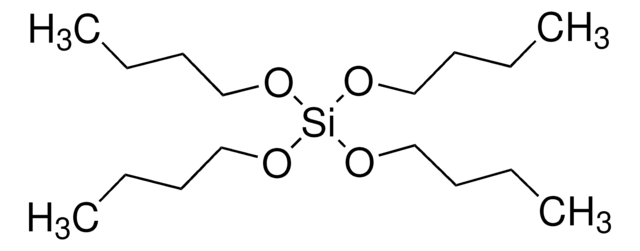Products may be shipped at a different temperature than the recommended long-term storage temperature. If the product quality is sensitive to short-term exposure to conditions other than the recommended long-term storage, it will be shipped on wet or dry-ice. If the product quality is NOT affected by short-term exposure to conditions other than the recommended long-term storage, it will be shipped at ambient temperature. As shipping routes are configured for minimum transit times, shipping at ambient temperature helps control shipping costs for our customers. For more information, please refer to the Storage and Transport Conditions document: https://www.sigmaaldrich.com/deepweb/assets/sigmaaldrich/marketing/global/documents/316/622/storage-transport-conditions-mk.pdf
131903
Ortosilicato de tetraetilo
reagent grade, 98%
Sinónimos:
Silicato de tetraetilo, TEOS, Tetraetoxisilano, Tetraetoxisilicio(IV), Tetraetóxido de silicio, Éster tetraetílico del ácido ortosilícico
About This Item
Productos recomendados
grado
reagent grade
Nivel de calidad
densidad de vapor
7.2 (vs air)
presión de vapor
<1 mmHg ( 20 °C)
Ensayo
98%
Formulario
liquid
índice de refracción
n20/D 1.382 (lit.)
bp
168 °C (lit.)
densidad
0.933 g/mL at 20 °C (lit.)
cadena SMILES
CCO[Si](OCC)(OCC)OCC
InChI
1S/C8H20O4Si/c1-5-9-13(10-6-2,11-7-3)12-8-4/h5-8H2,1-4H3
Clave InChI
BOTDANWDWHJENH-UHFFFAOYSA-N
¿Está buscando productos similares? Visita Guía de comparación de productos
Descripción general
Aplicación
- Como un antidisolvente para fabricar una capa eficiente de perovskita destinada a células solares planas invertidas con una mayor eficiencia de conversión de energía y reproducibilidad. El TEOS ayuda a lograr películas de perovskita de alta calidad con una densidad reducida de defectos y, por lo tanto, una recombinación más lenta del portador.
- Como precursor sol-gel para sintetizar recubrimientos antirreflectantes autolimpiantes de SIO2-Tio2 para células solares.
- Para fabricar membranas híbridas reticuladas funcionalizadas de nanosílice para aplicaciones de celdas de combustible con membrana de intercambio de protones. Estas membranas tienen una mejor conductividad de protones y estabilidad térmica.
- Preparar un separador de matriz de poli(fluoruro de vinilideno)/TEOS para mejorar el rendimiento de las baterías de iones de litio. El separador exhibe una excelente retención de electrólitos y humectabilidad.
Características y beneficios
- Excelente adherencia a los sustratos
- Disposición de película uniforme
- Reticulante para introducir hebras de polímero en hidrogel
Palabra de señalización
Warning
Frases de peligro
Consejos de prudencia
Clasificaciones de peligro
Acute Tox. 4 Inhalation - Eye Irrit. 2 - Flam. Liq. 3 - STOT SE 3
Órganos de actuación
Respiratory system
Código de clase de almacenamiento
3 - Flammable liquids
Clase de riesgo para el agua (WGK)
WGK 1
Punto de inflamabilidad (°F)
113.0 °F - closed cup
Punto de inflamabilidad (°C)
45 °C - closed cup
Equipo de protección personal
Eyeshields, Faceshields, Gloves, type ABEK (EN14387) respirator filter
Elija entre una de las versiones más recientes:
¿Ya tiene este producto?
Encuentre la documentación para los productos que ha comprado recientemente en la Biblioteca de documentos.
Los clientes también vieron
Artículos
Silica's versatility spans various industries, including biomedical applications.
Silica's versatility spans various industries, including biomedical applications.
Silica's versatility spans various industries, including biomedical applications.
Silica's versatility spans various industries, including biomedical applications.
-
How is shipping temperature determined? And how is it related to the product storage temperature?
1 answer-
Helpful?
-
-
How can I determine the shelf life / expiration / retest date of this product?
1 answer-
If this product has an expiration or retest date, it will be shown on the Certificate of Analysis (COA, CofA). If there is no retest or expiration date listed on the product's COA, we do not have suitable stability data to determine a shelf life. For these products, the only date on the COA will be the release date; a retest, expiration, or use-by-date will not be displayed.
For all products, we recommend handling per defined conditions as printed in our product literature and website product descriptions. We recommend that products should be routinely inspected by customers to ensure they perform as expected.
For products without retest or expiration dates, our standard warranty of 1 year from the date of shipment is applicable.
For more information, please refer to the Product Dating Information document: https://www.sigmaaldrich.com/deepweb/assets/sigmaaldrich/marketing/global/documents/449/386/product-dating-information-mk.pdfHelpful?
-
-
What is the Department of Transportation shipping information for this product?
1 answer-
Transportation information can be found in Section 14 of the product's (M)SDS.To access the shipping information for this material, use the link on the product detail page for the product.
Helpful?
-
-
Is anything else needed to use Product 131903, Tetraethyl Orthosilicate in a hydrolysis reaction?
1 answer-
An acid or alkali catalyst is needed to do a hydrolysis reaction to free the silanol group for use.
Helpful?
-
-
What is the freezing point of Product 131903, Tetraethyl Orthosilicate?
1 answer-
The freezing point is ~85°C.
Helpful?
-
-
How can I purify Product 131903, Tetraethyl Orthosilicate?
1 answer-
Fractionate through an 80cm Podbielniak type column with heated jacket and partial take-off head. [Purification of Laboratory Chemicals Fourth Ed]
Helpful?
-
-
Product 131903, Tetraethyl orthosilicate is commonly used as a precursor to prepare xerogel. What is xerogel?
1 answer-
A xerogel is a solid formed from a gel by drying with unhindered shrinkage. Xerogel usually retains high porosity and large surfaced area, along with very small pore size.
Helpful?
-
-
What is the solubility of Product 131903, Tetraethyl Orthosilicate?
1 answer-
According to the 13th Edition of the chemicals encyclopedia published by the Royal Society of Chemistry, Tetraethyl Orthosilicate is practically insoluble in water and is slowly decomposed by it. It is miscible with alcohol.
Helpful?
-
Active Filters
Nuestro equipo de científicos tiene experiencia en todas las áreas de investigación: Ciencias de la vida, Ciencia de los materiales, Síntesis química, Cromatografía, Analítica y muchas otras.
Póngase en contacto con el Servicio técnico












